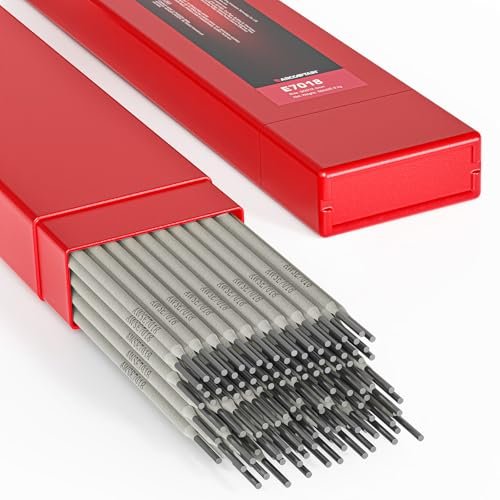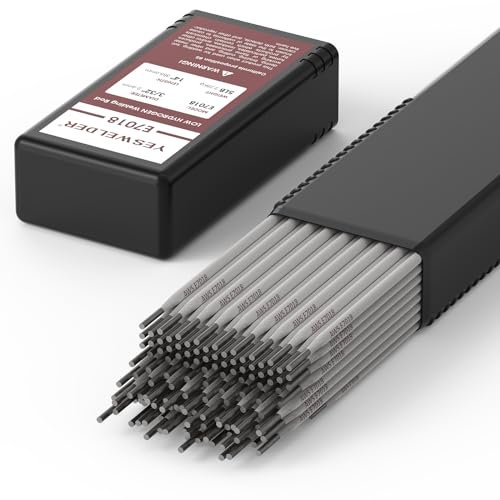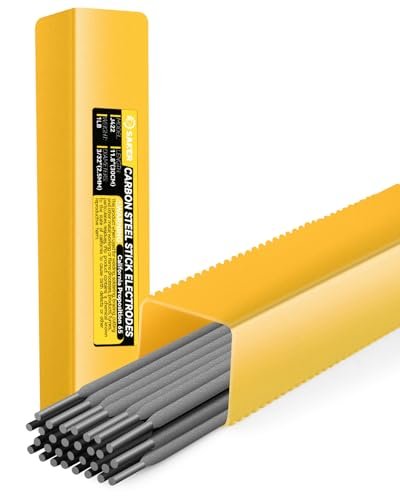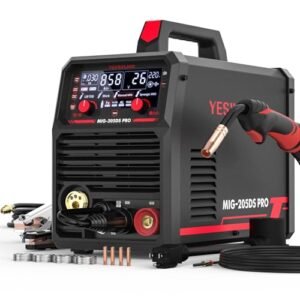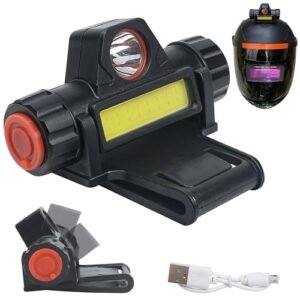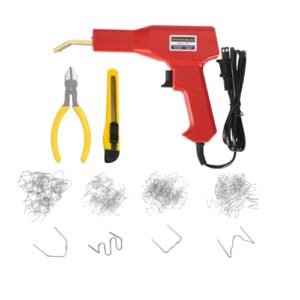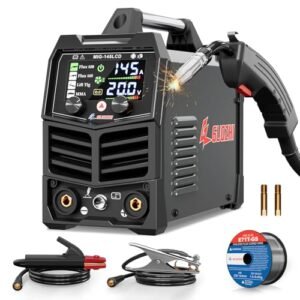As someone who’s spent countless hours under the hood, I know that choosing the right welding stick can make or break a project. It’s not just about getting the job done; it’s about achieving a clean, strong, and reliable weld. We’ve put some of the best welding sticks through their paces, from low-hydrogen carbon steel electrodes to versatile all-position options, to help you find the perfect match for your next task. Whether you’re a seasoned pro or just starting out, this guide offers hands-on insights into what truly works.
Contents
- YESWELDER E7018 1/8” 5LB Welding Rod Low Hydrogen Carbon
- ARCCAPTAIN E7018 Welding Rod 3/32” 5LB Low Hydrogen Carbon
- WISUNO Welding Rods, J422(E4303) 3/32″x14″ 1LB,Carbon Steel
- YESWELDER E7018 3/32” 5LB Welding Rod Low Hydrogen Carbon
- Saker E6013 Welding Rod 3/32” 1-Pound Carbon Steel Stick
- Comparative Insights on the Best Welding Sticks
- Final Verdict
- Best Welding Sticks: Frequently Asked Questions
- Q1: What are the main differences between E6013 and E7018 welding sticks?
- Q2: Can I use E7018 welding sticks with an AC welder?
- Q3: Why is “low hydrogen” important for welding rods like E7018?
- Q4: What diameter welding stick should I use for different metal thicknesses?
- Q5: How should I store my welding sticks to maintain their quality?
- Q6: Can beginners use E7018 welding sticks?
YESWELDER E7018 1/8” 5LB Welding Rod Low Hydrogen Carbon
The YESWELDER E7018 1/8” stick is a powerhouse for structural work and critical applications where weld integrity is paramount. This low-hydrogen, iron powder type electrode consistently produces high-quality, X-ray-grade welds, making it a favorite among professionals. It’s incredibly versatile, working across all positions with both AC and DC reverse polarity, meaning you can tackle complex geometries without switching rods. Its formulation is especially adept at welding medium carbon steels without preheat, and it effectively prevents porosity in cold-rolled steels, which is a huge time-saver.
-
Key features that stand out:
- Low-hydrogen iron powder type for superior weld quality.
- All-position welding on AC or DC reverse polarity.
- Steady arc, low spatter, and excellent re-striking ability.
- High deposition efficiency for faster work.
- Ideal for low, medium, and high carbon steels and structural components.
-
Pros:
- Produces exceptional X-ray quality welds, crucial for critical jobs.
- Great arc stability and easy re-striking capabilities.
- Highly effective on steels that typically pose porosity challenges.
- Excellent for heavy fabrication and demanding applications.
-
Cons:
- Requires proper rod storage to maintain low-hydrogen properties.
-
Best for: Professional welders, heavy fabrication, structural steel, offshore rigs, and power plant applications where strength and integrity are non-negotiable.
-
Expert Opinion: This E7018 in the 1/8” diameter is a workhorse. Its robust performance and ability to handle various carbon steel types make it a go-to for serious fabrication. The arc starts smoothly, and the puddle control is excellent, leading to very clean and strong welds.
ARCCAPTAIN E7018 Welding Rod 3/32” 5LB Low Hydrogen Carbon
The ARCCAPTAIN E7018 3/32” rod is another top contender for those needing reliability in critical situations, but in a slightly smaller diameter. Like its 1/8” counterpart, this low-hydrogen, iron powder electrode delivers outstanding X-ray quality welds and exceptional tensile strength. What sets it apart is its excellent resistance to cracking, a vital characteristic for longevity in challenging environments. With a smooth, stable arc and minimal spatter, it makes achieving clean, high-integrity welds easier, even for complex or high-pressure components.
-
Key features that stand out:
- Low-hydrogen E7018 for superior weld integrity and X-ray values.
- High tensile strength and excellent crack resistance.
- Smooth and stable arc with minimal spatter.
- High melting efficiency for productive welding.
- Suitable for a wide range of applications including pipelines and marine structures.
-
Pros:
- Exceptional for high-stress applications due to superior tensile strength.
- Reduced risk of cracking, enhancing weld durability.
- Consistent performance across various welding positions.
- Great for intricate work and thinner materials compared to 1/8” rods.
-
Cons:
- Being a low-hydrogen rod, it requires careful handling and storage.
-
Best for: High-pressure pipelines, ship hulls, marine structures, power generation equipment, and any application requiring excellent crack resistance and high tensile strength on medium to high carbon steels.
-
Expert Opinion: The ARCCAPTAIN E7018 3/32” is fantastic for precise work that still demands high strength. Its controlled arc and low spatter mean less cleanup, and the added crack resistance is a huge bonus for long-term performance in demanding conditions. It’s truly a premium choice for critical structural welds.
WISUNO Welding Rods, J422(E4303) 3/32″x14″ 1LB,Carbon Steel
For those who prioritize ease of use and versatility for everyday tasks, the WISUNO J422 (E4303) is an excellent choice. This carbon steel electrode is incredibly user-friendly, making it a favorite for both beginners and seasoned pros working on general fabrication. Its key advantage is strong adaptability, tolerating surfaces that might be lightly rusted, oxidized, or even painted, which significantly cuts down on prep time. Plus, with easy arc ignition, low spatter, and simple slag removal, your welding process becomes smoother and more efficient, reducing post-weld cleanup.
-
Key features that stand out:
- All-position welding capabilities (flat, horizontal, vertical, overhead).
- User-friendly with easy arc ignition, great for beginners.
- Low spatter and easy slag removal for less cleanup.
- Strong adaptability to less-than-perfect surface conditions.
- Cost-effective for general carbon steel applications.
-
Pros:
- Extremely easy to start and maintain an arc, even for novices.
- Forgiving on material prep, saving time and effort.
- Minimal spatter and self-peeling slag make cleanup a breeze.
- Affordable for general repair and light fabrication.
-
Cons:
- Not designed for critical, high-strength applications where E7018 is required.
-
Best for: Beginners learning to weld, general fabrication, home repairs, light structural work, and situations where you need a versatile, forgiving, and economical electrode for common carbon steel.
-
Expert Opinion: This J422 rod is a fantastic everyday utility stick. It really shines in its ability to handle imperfect surfaces, which is a real-world benefit. The arc is forgiving, and it produces a visually appealing bead with minimal fuss. It’s the kind of rod you grab when you just need to get the job done reliably and efficiently.
YESWELDER E7018 3/32” 5LB Welding Rod Low Hydrogen Carbon
The YESWELDER E7018 3/32” is essentially a smaller diameter version of the 1/8” YESWELDER E7018, offering the same high-quality, low-hydrogen performance but with more control for thinner materials or tighter joints. This electrode is perfect for welders who need the robust characteristics of an E7018 rod – such as X-ray quality welds, high tensile strength, and excellent crack resistance – but prefer the precision that a 3/32” diameter provides. It maintains a steady arc, produces minimal spatter, and offers excellent re-striking ability, making it a highly reliable choice for precise structural work and critical repairs.
-
Key features that stand out:
- Low-hydrogen E7018 for superior strength and weld integrity.
- All-position usability with AC or DC reverse polarity.
- Steady arc, low spatter, and exceptional re-striking.
- High deposition efficiency for productive welding.
- Ideal for low, medium, and high carbon steels in smaller thicknesses.
-
Pros:
- Provides the same professional-grade welds as its larger counterpart.
- Better suited for detailed work or materials requiring less heat input.
- Reliable arc characteristics make it easy to control the weld puddle.
- Excellent for structural welds where a 3/32” rod is preferred.
-
Cons:
- Like all low-hydrogen rods, it requires specific storage conditions.
-
Best for: Precision structural welding, smaller gauge medium to high carbon steels, intricate fabrication, and repair work where the strength of E7018 is needed but a smaller rod diameter is beneficial for control.
-
Expert Opinion: The 3/32” E7018 from YESWELDER is a fantastic option for those who need the uncompromising quality of a low-hydrogen rod but in a more manageable size for precise applications. It runs smoothly, offering excellent control, especially when dealing with tighter fit-ups or thinner sections where excessive heat can be an issue.
Saker E6013 Welding Rod 3/32” 1-Pound Carbon Steel Stick
The Saker E6013 3/32” is a highly versatile and user-friendly carbon steel electrode, particularly well-suited for light metal fabrication and repairs. What makes it stand out is its ability to perform exceptionally well with low-voltage AC machines, making it accessible for a wide range of setups, including those commonly found in home workshops. Its shallow penetration is ideal for working with poor-fit-up conditions and thinner materials, ensuring smooth and consistent welds without burning through. Easy arc start, minimal spatter, and excellent slag removal (often self-cleaning for vertical-down welds) contribute to a cleaner, more efficient welding experience for both beginners and experienced hands.
-
Key features that stand out:
- Versatile E6013 works with both AC and DC, especially good with low-voltage AC.
- All-position welding with shallow penetration, ideal for poor fit-up.
- Easy arc start and minimal spatter for clean welds.
- Excellent slag removal, often self-cleaning for vertical-down.
- Specifically designed for low-carbon steel, sheet metal, and thin materials.
-
Pros:
- Extremely easy to use, making it perfect for beginners.
- Forgiving with less-than-perfect material fit-up.
- Operates well on basic AC welders.
- Produces clean welds with very little post-weld cleanup.
-
Cons:
- Not suitable for high-stress structural applications requiring deep penetration.
-
Best for: Beginners, DIY enthusiasts, light metal fabrication, sheet metal work, pipe welding (thin gauge), small repair jobs, and anyone needing a reliable, easy-to-use rod for low-carbon steel projects.
-
Expert Opinion: The Saker E6013 is the friendliest stick in the bunch, hands down. For someone just learning or doing general home repairs, it’s unbeatable. The arc is gentle, slag peels right off, and it runs beautifully even on less powerful machines. It’s a great introductory rod that still yields good results for experienced welders on appropriate materials.
Comparative Insights on the Best Welding Sticks
When looking at the best welding sticks, understanding their core differences is key. The E7018 electrodes (YESWELDER and ARCCAPTAIN) are the clear winners for high-strength, critical applications where X-ray quality and resistance to cracking are paramount. Their low-hydrogen nature means they produce very sound welds, but they do demand careful storage. The 1/8” YESWELDER is excellent for heavier sections and high amperage, while the 3/32” ARCCAPTAIN and YESWELDER offer more precision for thinner materials or more delicate structural work.
In contrast, the WISUNO J422 (E4303) and Saker E6013 are your go-to options for general-purpose welding and ease of use. They are much more forgiving on surface contaminants like rust or paint, making them ideal for quick repairs or projects where extensive prep isn’t feasible. The E6013, in particular, shines with its shallow penetration, perfect for sheet metal and thin materials, and it runs exceptionally well on basic AC machines. The J422 is also incredibly beginner-friendly with its easy arc ignition and minimal spatter. While they don’t offer the extreme strength of E7018, their user-friendliness and adaptability make them invaluable for DIYers and light fabrication. Choosing between them often comes down to the specific material thickness and the required weld strength for your project.
Final Verdict
For professionals and demanding structural projects, the YESWELDER E7018 (either 1/8” or 3/32”) and ARCCAPTAIN E7018 (3/32”) are the undisputed champions. They consistently deliver X-ray quality, high-strength welds that can withstand rigorous inspection and harsh conditions. If you need robust performance for critical infrastructure, these are your picks.
However, for the everyday welder, the DIY enthusiast, or anyone tackling general repairs and light fabrication, the WISUNO J422 (E4303) and Saker E6013 offer unmatched ease of use and versatility. The Saker E6013 particularly stands out for its beginner-friendliness and excellent performance on low-carbon steel and thin materials, even with less powerful welders. If your projects prioritize ease of operation, minimal cleanup, and adaptability to less-than-perfect surfaces, these general-purpose rods will serve you exceptionally well.
Ultimately, the “best” welding stick depends entirely on your specific project, skill level, and equipment. Carefully consider the material, required strength, and your experience before making your choice.
Best Welding Sticks: Frequently Asked Questions
Q1: What are the main differences between E6013 and E7018 welding sticks?
A1: E6013 rods are known for their versatility and ease of use, making them great for beginners and general fabrication on low-carbon steel, especially with shallow penetration. They offer good arc stability and easy slag removal. E7018 rods, on the other hand, are low-hydrogen, high-strength electrodes designed for critical applications and structural welding. They produce X-ray quality welds with excellent tensile strength and crack resistance, ideal for medium to high carbon steels and thick materials.
Q2: Can I use E7018 welding sticks with an AC welder?
A2: Yes, many E7018 welding rods are designed to be used with both AC and DC reverse polarity (DCEP) welding currents. Always check the manufacturer’s specifications on the rod packaging to confirm compatibility, as some E7018 electrodes might perform better on DC.
Q3: Why is “low hydrogen” important for welding rods like E7018?
A3: Low hydrogen content in welding rods like E7018 is crucial for preventing hydrogen-induced cracking, also known as delayed cracking or cold cracking. This type of cracking can severely compromise the strength and integrity of a weld, especially in high-strength steels. Maintaining low hydrogen levels in the weld deposit ensures superior mechanical properties and reduces the risk of defects in critical applications.
Q4: What diameter welding stick should I use for different metal thicknesses?
A4: Generally, thinner materials require smaller diameter welding sticks, while thicker materials can handle larger diameters. For example, a 3/32″ (2.5mm) stick is common for thin to medium materials (1/8″ to 1/4″ thick), offering good control. A 1/8″ (3.2mm) stick is better suited for medium to thick materials (3/16″ and up), providing higher deposition rates and deeper penetration. Always consult welding charts and practice on scrap metal to determine the optimal rod size and amperage for your specific project.
Q5: How should I store my welding sticks to maintain their quality?
A5: Proper storage is vital, especially for low-hydrogen electrodes like E7018. They should be kept in a dry, airtight container or a rod oven to prevent moisture absorption. Moisture in the flux can introduce hydrogen into the weld, leading to defects. General-purpose rods like E6013 are less sensitive but still benefit from dry storage to maintain performance.
Q6: Can beginners use E7018 welding sticks?
A6: While E7018 rods produce high-quality welds, they can be a bit more challenging for absolute beginners due to their quicker freezing puddle and specific storage requirements. E6013 or E6011 rods are generally recommended for beginners because they are more forgiving, easier to strike an arc with, and more tolerant of imperfect surface conditions. Once a beginner gains experience with arc control and puddle manipulation, transitioning to E7018 for more advanced projects is a natural progression.
Affiliate Disclosure: As an Amazon Associate, I earn from qualifying purchases made through links on this site.



